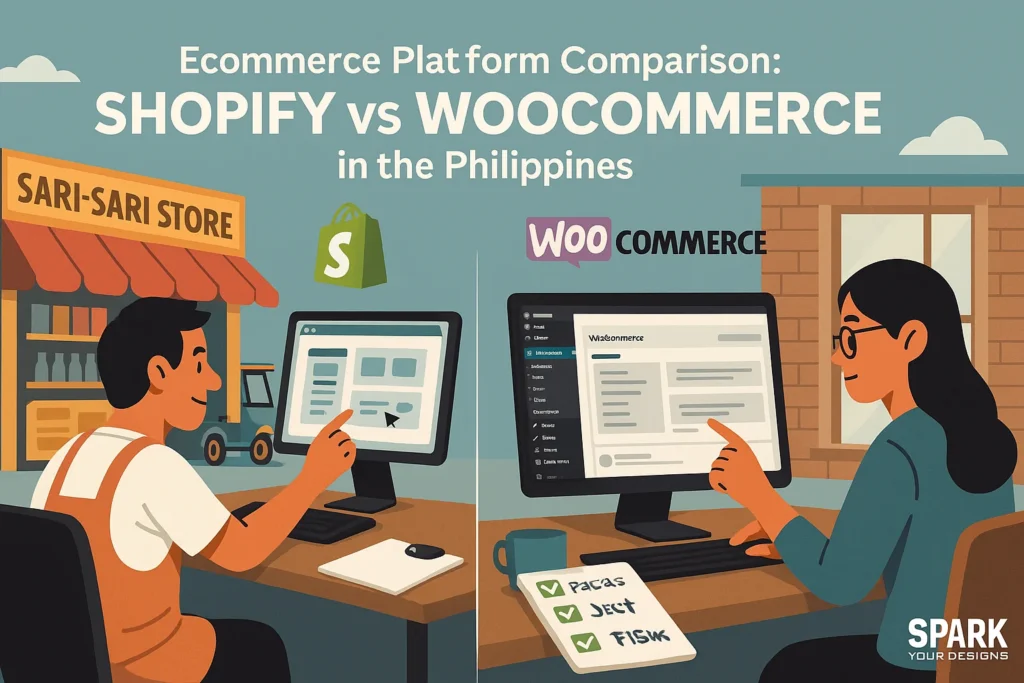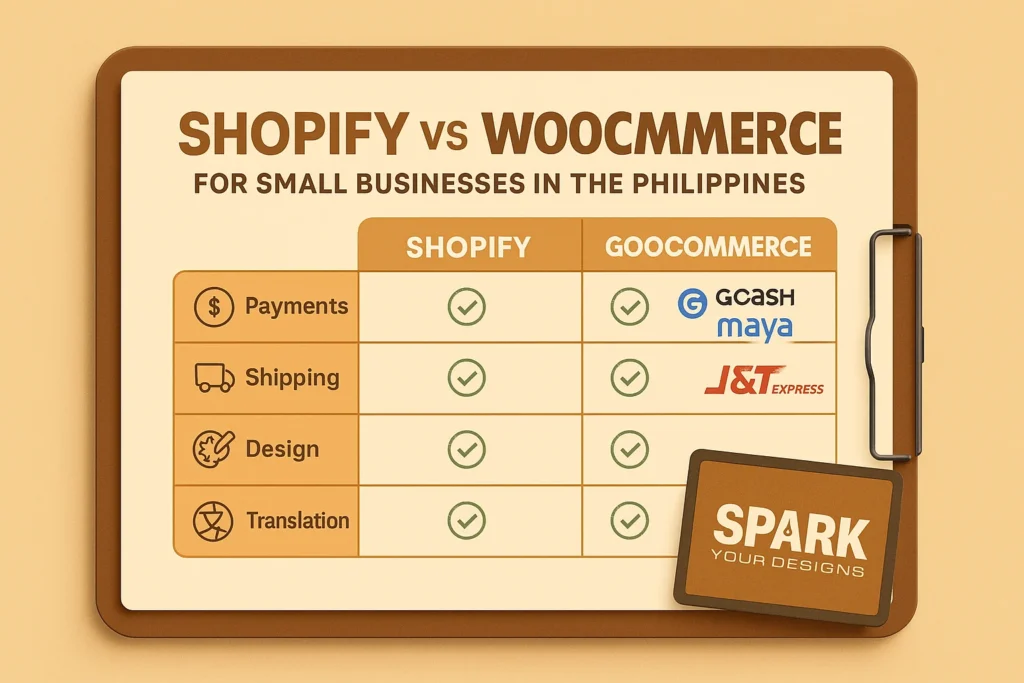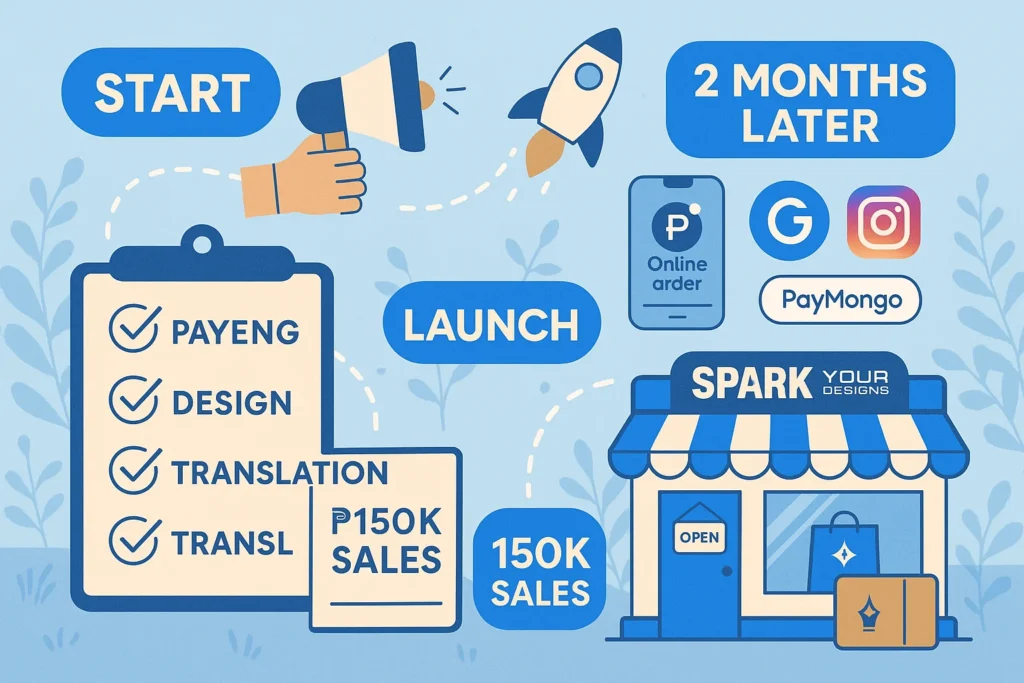Shopify vs WooCommerce: Best Platform for PH Stores
July 24, 2025

Table of Contents
“More than 76 million Filipinos shopped online in 2024—and that number is still going up.”
Starting an online store in the Philippines can be exciting—but also overwhelming. One of the first and biggest decisions you’ll make is choosing the right platform for your store. This decision affects how easy your website is to use, how much it costs, and how well it helps you grow your business over time.
I’ve worked with many Filipino entrepreneurs—some launching their first sari-sari store online, others building fashion brands, food delivery services, or custom product shops. I’ve built stores on both Shopify and WooCommerce. And here’s what I’ve learned: there’s no one-size-fits-all answer, but there is a best fit for different needs.
In this guide, I’ll walk you through how Shopify vs WooCommerce for small business in the Philippines compares. I’ll share real stories, break down the costs, and give you a clearer picture of how each works with local payment tools, shipping, and long-term growth.
Let’s jump into this ecommerce platform comparison and help you pick the right one for your business. If you want to learn more about design trends in our region, check out this blog post. And for a worldwide comparison, here’s a great external breakdown.
Ecommerce Platform Comparison: Shopify vs WooCommerce in the Philippines
Think of Shopify like renting a condo unit in a building that already has security, utilities, and furniture. You just move in, decorate a little, and pay your rent every month. It’s fast and simple.
WooCommerce, on the other hand, is like building your own house. You buy the land (your hosting), design everything yourself, choose how many rooms (pages), and even decide what kind of front door you want (checkout process). It’s more work at the start, but in the long run, it gives you total control.
One of my clients—a fashion brand from Cebu—chose Shopify first. At first, it looked sleek and ran well. But then she wanted to add GCash, pre-order forms, and a custom checkout layout. Shopify required paid apps for most of that. It added ₱3,000/month in fees.
So we rebuilt the site in WooCommerce. No extra app fees. Full control. And her site even loaded faster.
The real win? She could manage it herself after just a week of training. She didn’t have to rely on a developer every time she wanted to update a product or change a banner.
Shopify vs WooCommerce Features for Small Business in the Philippines

Here’s what local business owners should focus on when choosing a platform:
- Payments: WooCommerce supports GCash, Maya, PayMongo, bank transfers, and even Cash on Delivery—all directly. Shopify can do it, but you’ll need paid third-party apps.
- Shipping: WooCommerce works well with local courier integrations like LBC, J&T Express, and Ninja Van. Shopify doesn’t offer native support for these.
- Design Flexibility: Shopify gives you a polished look with templates, but it’s limited unless you upgrade or hire a developer. WooCommerce lets you build exactly what you need.
- Local Language and Checkout: WooCommerce can be translated easily and adjusted for Filipino buyers. Shopify has fewer tools for this without apps.
Another client—running a local meal prep service—wanted to offer Cash on Delivery and pickup times per barangay. Shopify couldn’t handle those rules. WooCommerce? No problem at all.
He also wanted to print daily delivery reports and automatically notify customers via SMS. Again, WooCommerce delivered with a few plugins and no ongoing monthly fees.
Starting an Online Store in the Philippines: Which Platform Fits Best?

If you’re in Cebu or want to learn about regional design trends, check out our Cebu-specific guide.
If your budget is limited and you need something live quickly, Shopify might seem easier. But it comes with higher long-term costs:
💸 Shopify basic plan: ~₱1,200/month
💸 Add-on apps: ₱2,000–₱4,000/month
💸 Want custom features? You’ll need to pay a developer
With WooCommerce:
- You’ll spend more upfront (hosting, design, setup)
- Monthly fees are lower or none at all
- You own your site, your data, and your design
- You’re free to change things without extra subscriptions
Plus, WooCommerce is built on WordPress, which means it’s great for content marketing too. You can run a blog, add pages for promotions, or even launch an email newsletter—right inside your dashboard.
This makes WooCommerce the smarter choice for many Filipino businesses—especially if you want to grow.
Shopify vs WooCommerce Features in Action: Case Study from a Cebu Client
Let me tell you about Rachel, a client based in Cebu City. She runs a clothing business and wanted to go online. Her must-haves were: local payment options, simple pre-orders, and a layout that matched her Instagram vibe.
We chose WooCommerce, and here’s what we built:
- GCash and PayMongo integration
- Delivery zones by city
- Mobile-friendly product galleries
- An easy-to-update blog
- Local SEO targeting Cebu and surrounding areas
In just 2 months, she made over ₱150,000 in sales—without spending on ads. Everything came from organic traffic, social media, and word-of-mouth.
Today, she’s managing inventory through her phone and even planning to launch a second product line with upsell features—all within WooCommerce.
If she stayed on Shopify? She would’ve paid more, and her layout wouldn’t feel as local.
Shopify vs WooCommerce for Small Business in the Philippines: Which Should You Choose?
Here’s a simple chart to compare the two platforms:
| Feature | Shopify | WooCommerce |
|---|---|---|
| Setup Time | Fast and easy | Slower but more flexible |
| Monthly Cost | Higher | Lower |
| Local Payment Options | Needs apps | Built-in support |
| Customization | Limited | Full control |
| SEO and Blog Features | Basic | Advanced |
| Language & Translation | Limited | Fully customizable |
| Ownership | You rent it | You own it |
Shopify is quick. WooCommerce is powerful.
Also, WooCommerce integrates well with analytics tools like Google Tag Manager, Facebook Pixel, and even marketing automation platforms. You can really take control of your sales funnel.
Final Thoughts on Shopify vs WooCommerce for Small Businesses in PH
So, what’s the verdict?
If you’re just testing a product or want something that works right now with little effort—Shopify is a decent choice.
But if you want to grow, customize, and offer a truly local experience, WooCommerce is better. You save more in the long run. You avoid limitations. And you can build a site that’s truly yours.
I’ve helped many small businesses make the switch—and they never look back.
In fact, many clients who switched from Shopify to WooCommerce told us they finally felt “in control” of their store.
What’s Next?

Starting your online store doesn’t have to be stressful. At Spark Your Designs, we build Shopify and WooCommerce sites for Filipino entrepreneurs who want to get it right the first time.
👉 Start a project with Spark Your Designs today
We’ll help you:
- Choose the right platform
- Design your site
- Set up payments and delivery
- Launch confidently
Whether you’re just beginning or ready to scale—we’re here to help you build a store that works.
Frequently Asked Questions about Shopify vs WooCommerce for Small Businesses in PH
1. Is WooCommerce harder to manage than Shopify?
WooCommerce may take a bit more effort initially, but it quickly becomes easy to manage once set up. I train my clients to update their WooCommerce sites in just a few hours.
2. Can Shopify integrate with local payment methods easily?
Not without additional apps and monthly fees. WooCommerce integrates smoothly with local options like GCash and Maya without extra charges.
3. Which platform is better for SEO in the Philippines?
WooCommerce typically performs better because it offers more control over metadata, URLs, and content.
4. How long does it take to set up WooCommerce vs Shopify?
Shopify can be ready within a few days. WooCommerce usually takes one to two weeks for a full setup but provides far greater customization.
5. Are there hidden costs in Shopify?
Yes. While Shopify seems affordable initially, the cost of premium apps, payment gateway fees, and higher-tier plans can add up quickly.
6. Shopify vs WooCommerce Features: Which has better security?
Both Shopify and WooCommerce offer strong security. Shopify handles security for you, but WooCommerce lets you add custom security measures easily.
7. Ecommerce Platform Comparison: Can I easily switch from Shopify to WooCommerce?
Yes! Migrating from Shopify to WooCommerce is straightforward. We often help businesses in the Philippines move smoothly without losing their data.
8. Starting an Online Store in the Philippines: Which platform is cheaper long-term?
WooCommerce is usually cheaper long-term because you avoid monthly fees for apps and premium features. Shopify’s monthly fees can add up.
9. Shopify vs WooCommerce Features: Which one offers better customer support?
Shopify provides built-in support through email and chat, but WooCommerce has a huge online community, many tutorials, and professional local developers ready to help.
10. Ecommerce Platform Comparison: Can WooCommerce handle large product catalogs?
Absolutely! WooCommerce easily manages large inventories and product variations, making it ideal for growing businesses in the Philippines.



